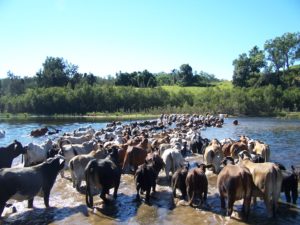Read the latest information on
Foot-and-mouth disease
 Across Australia, extreme weather comes and goes with the seasons. Fires, flood, droughts and storms have formed part of the short- and long-term cycles of weather on this continent forever.
Across Australia, extreme weather comes and goes with the seasons. Fires, flood, droughts and storms have formed part of the short- and long-term cycles of weather on this continent forever.
As we move further into summer and the fire danger continues to escalate, Animal Health Australia are urging livestock producers to closely consider the needs of their animals before, during and after a natural disaster.
Naturally, in the heat of the moment, you do whatever you need to do to ensure that lives are not lost. However, according to Dr Simon Humphrys, AHA’s Executive Manager, Biosecurity and Product Integrity, any amount of time spent in planning can save you from significant problems down the line.
Dr Humphrys acknowledged there’s a lot to take into account, explaining that “while you’d be forgiven for not evacuating with a copy of your biosecurity plan, the recovery phase of a disaster has big implications for animal health, often changed biosecurity risks, and keeping a business running under challenging circumstances,”
“It’s important to have an idea of how you’ll not only prepare for and respond to a natural disaster, but how you’ll bring livestock back to the property.”
Producers in disaster-prone areas likely already have disaster management and evacuation plans; these should complement their biosecurity plan by addressing biosecurity and traceability requirements in the event that livestock need to be moved from the property.
“If you have enough warning to evacuate, you should have a clear idea of where your livestock are going to go, and what kinds of conditions they’ll be kept in,” said Dr Humphrys.
“Ensuring they’ll have access to feed and water that is free of diseases and other contaminants is paramount, as is ensuring that any mixing of stock from different herds is kept to a minimum wherever possible.”
If you’re unable to evacuate in time, having a contingency plan for where the stock will be kept on your own property is a sound backup strategy.
Any movements to and from the property also ultimately need to be logged with the NLIS database, in keeping with the relevant legislation in your state and territory.
As you head into the recovery phase, ensuring the property is able to both support (feed-base) and contain livestock are obviously the top priorities.
“Checking the integrity of your external fences and ensuring feed, water and shelter are available are the bare minimum before you consider bringing livestock back onto the property,” Dr Humphrys explained.
“Once you’re sure livestock can return, reintroduce them to the property as you would any new introductions: this involves keeping them isolated in a yard or smaller paddock and watching for signs of illness, injury or weeds popping up.”
Depending on the nature of the disaster there may be other factors to consider, such as whether feral animals and wildlife may have sought shelter on the property, whether there may be carcasses and weed seeds left behind, or whether the conditions on the property have created a breeding ground for insects, which may carry diseases.
“While you’ll likely have a lot to do over the following days and weeks, it’s important that you continue to monitor livestock and yards for new biosecurity threats,” Dr Humphrys said.
“It’s easy to miss something while scrambling to get your business operational again, but you don’t want your disaster recovery to be followed by a disease outbreak.”
For more information on assembling a biosecurity plan for your property, click here.